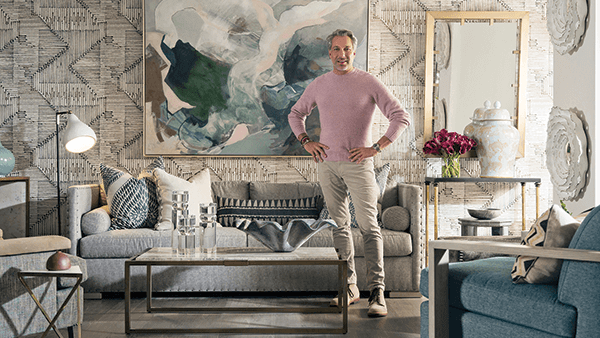
The celebrity designer shares his thoughts on why it’s important for designers to become more involved in the mattress industry.
World-renowned interior designer Thom Filicia counts Jennifer Lopez and Tina Fey among his clients, according to Architectural Digest. He also partners with brands like Radio City Music Hall and Delta Air Lines. And while he may be best known for his role on “Queer Eye for the Straight Guy” and appearances on “The Oprah Winfrey Show” and “The Ellen DeGeneres Show,” Filicia is also behind one of the world’s most influential design firms, Thom Filicia Inc., based in New York. Here’s what he has to say about designers joining forces with mattress manufacturers, as well as current mattress trends and modern bedroom design.
Why is it important for designers to get involved with the bedding industry?
From manufacturing to distribution to the end user understanding mattresses, I think a designer is a really great resource to connect with a manufacturer. We are so rooted in manufacturing, and we are a design firm. I just feel it’s a natural fit.
For a lot of people, there’s a mystery surrounding bedding, especially now when every time you turn around, there’s a new bedding company or there’s a new type of mattress. There are some that breathe, there are some that go up and down, there are some that are 14 inches thick, and there are some that are 12 or 10 inches thick. Or there are some that are $4,000 or $10,000, with some that are $900.
I think having a trusted source like a designer helps if you’re a homeowner or a hotel brand. It’s having somebody that fits your point of view, your aesthetic, who you trust as someone who is an authority on home and lifestyle. I think it would be a lot easier to know what a designer looks for in a mattress — the look and feel, the price point, the thickness for bedding, and all of those other elements — so that consumers can navigate those waters more effortlessly and with confidence.
Whether (the consumer is) a homeowner, architect or hotel, designers can give them competence and information. So, customers feel like they are making a really great choice without having to do research and then having to go sit on every mattress. Designers can give consumers the confidence to make a decision.
How would it benefit you as a designer to partner with a mattress manufacturer?

I think it’s mutually beneficial for designers and manufacturers to partner. I would love for my design firm to be able to say (to a client), “This is where we start. These are our four or five go-to mattresses that we love.” We would use those in our firm and in our showrooms. We would be able to communicate about those beds in meetings with clients. A lot of times when the designer doesn’t really have a go-to product, their customers do it on their own. And mattresses can get lost in the shuffle. There’s nothing worse than showing up at an installation with beautiful beds and no mattresses because the client never did it. Or they buy a mattress and they’re not happy. And then they don’t want to get a good mattress because they’ve already spent $1,200 on something that they’re not happy with.
Until you understand a product, you gravitate toward someone you trust who will be able to give you information. Having my own mattress line would be really helpful for the designers in my office because they would be able to say, “This is our go-to firm; this is our go-to soft. These are the things that we really love. We not only like the look of it and the feel of it, but it’s the right size, it’s incredibly comfortable, it’s organic, it’s healthy. It’s something that we feel confident selling.” It’s also about having a relationship with a manufacturer, someone that will stand behind the product. When you have a relationship, the business is a different process, an easier process. You end up getting generally what you want, and if you don’t, it’s an easy switch. And everybody’s happy.
You’ve said in the past that your partners get the benefit of your expansive marketing efforts. Are there any other benefits for mattress manufacturers?
Designers look to other designers for information. The more that we share information and experience and expertise, the more I think the product has legs.
Designers will also talk about the product incessantly because they love working with the manufacturer and they love the product. And they’ll know the details that most people don’t know about mattresses. So, I think it’s a little bit of an untapped moment in the bedding world.
I wish we had mattresses not only for our business, but I would love to take a product that we really love and get behind it and be a part of that product having a much stronger presence, not only in terms of sales, but also in terms of within the design community. … I want to be able to believe in the product, understand the manufacturing, understand the materials and the health benefits, the ergonomics of it, the size of it … and be a part of telling that story.
If you could change one thing about mattresses, what would it be?
Mattresses are different today, and you need to educate yourself and understand them because it’s something that you are on at least a third of your life. I would break them down and make them much more understandable and user-friendly. I would also design the mattresses to complement the interior when they’re sitting naked, and the sheets and bedding are being cleaned. I would talk a lot about the sizes of the mattresses and the benefits to those sizes, the different thicknesses of mattresses, because I don’t think a lot of people understand why some mattresses are 18 inches or 14 inches, and some are 10, 11 or 12 inches.
If you were going to have your own mattress line, what’s one must-have for the collection?

I like it when things are competitive in price point; I’m not looking for the most expensive mattress in the world. I’m not looking for the mattress made from the most exotic or rare materials. It’s about creating something where there’s a balance of sustainability, a balance of health and wellness, and it’s all understandable. I want it to be the kind of thing where purchasing a mattress is as easy as ordering lunch.
What is your point of view when you design a bedroom?
The first thing I do is look at the architecture and the livability of the house. Is this a primary residence or a secondary residence? Is it a beach house or a ski house? Are the people early risers or do they stay up late? The way I design a bedroom where somebody gets up every day at 6 a.m. for work is very different from the way I would approach that same room if that’s where they go on the weekends. Then I come up with two or three different layouts, with really creative and interesting ways to make the experience of that room feel unique and thoughtful for that environment. So, when people are in it, they feel like it’s an oasis, whether it’s a place where they’re getting away from work or whether it’s where they’re relaxing after a long day of hiking.
How has the pandemic changed the bedroom?
The bedroom has become like many rooms in our homes — now we think about how to best capitalize on that real estate and square footage. We want rooms to be multifunctional so that they can ebb and flow with what’s needed at any time. Sometimes you’re in the bedroom because you’re under the weather. You also want a place that’s suitable for whether you’re single or in a relationship. It’s also where a
family can connect and snuggle and be close. It’s a great place to read. It’s where you can comfortably get some work done or recharge your batteries before going to dinner. The bedroom is a private space, but there are moments when it needs to be semi-public. And you want it to be able to do all that.
How do you define the modern bedroom?
The modern bedroom is not just a sheet set and matching pillows and a duvet. We look at it as fashion, and it needs to be something that represents our personal style, acclimates to the seasons, and comforts us in a variety of situations, from relaxation to entertaining to recuperating to working and playing. The modern bedroom is not as practical and limited as it once was. The rooms that we live in now tell our story and are bespoke to our lifestyle and our point of view. The bedroom is where we recharge our batteries and where we think about life and love, and it should be inspiring, comfortable, stylish, cool and warm. All the best attributes that you would say about your best friend are the same things you should say about your bedroom and your sleeping experience.




